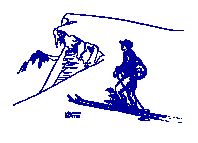
During the winter when most climbers are not pursuing peaks, I like to break out my skis and go exploring new possibilities. In the winter of 2015/2016, I decided to look at a nice little cluster of Sierra peaks in Yosemite National Park that I deemed most reachable from Badger Pass. When planning such a mini week Iong solo expedition, I to try to keep the weight down, but once I start piling on the crampons, ice axe, cold weather gear, skis, and boots, my pack can get heavy, which meant I wasn't going to be setting any speed or distance records. My initial goal was to ski down to and across Illiiouette Creek to set up a base camp for exploring.
Well, this was not a very big snow year, so the snow bridges weren't as sturdy as I would have liked and after breaking through and sinking up to one knee on my left leg and one boot on my right, I decided to make camp without crossing to try to dry my boots and pants. By morning the pants were frozen stiff, so I didn't exactly bolt right up at 6:30 a.m.as it wasn't even light yet. But I finally got moving upstream, looking for a better snow bridge around mid-morning and was able to make it across and set up an excellent base camp for Starr King.
The next day I got off to what I considered an early start with just a daypack to check out the snow that I expected to see on the north side of the 5th class rated Mt. Starr King. The snowpack was nicely consolidated, so I was able to make good time and saw that the snow went up as far as I could see. The terrain steepened quickly and before long I was taking off my skis and putting on my crampons and breaking out my ice axe. The view looking up showed steep but probably do-able climbing if the snow remained as snow and not ice. The angle of the snow surface was consistently 45 degrees and greater. The exposure was intimidating to me as I knew that if a crampon didn't hold, I would be destined to be a pin ball headed straight to a forest that wasn't going to let me get through without some serious collisions. Keeping my focus on my immediate vicinity with occasional stops to hyperventilate, I stepped into some soft pockets near the top where there was a hint of a cornice and that it was the final and steepest section before I would feel at ease.
The summit is a large, nearly flat dome with an easy walk to a conspicuous high point. Seeing the bolted down custom aluminum register wasn't what I expected but was pleased to see. The weather was clear, and the views were as spectacular as they can get. Yosemite Falls was gushing at maximum water volume. Half Dome, which was my first Sierra peak in 1967 and on which I spent the night to watch the firefall be pushed off Glacier Point, dominated the view of the Valley. Mount Clark, Gray Peak, and Red Peak stood higher to the east with snow all around. I was on the summit for about forty-five minutes, taking in much of the grandeur all around, then decided to begin my downclimb facing into the mountain for about 90% of the way down. At the bottom, I switched from crampons to skis and enjoyed such an exceptional ski down that I overshot my camp and wound up having to do the climb back up well past sunset.
After a good night's rest, it was time to move camp higher, which was an all-day effort. The following day was spent exploring the North Arete of Mount Clark. I got within 200 vertical feet of the summit and was stopped by clear water ice that I wasn't prepared to deal with. The views from my high point were again spectacular. The ski back to camp was on virtual ego snow and led straight to camp this time. For the next day, I set my site on Gray Peak and was making decent progress on the West Ridge as the wind picked up, clouds came in, and snow began to fall. I looked at my overall situation and decided I would have to try Gray again at some other time. The weather looked like it was going to show me its wintery side, and my best option was to head back to camp. During the night, I got about a foot of new snow and was at my turn around time for the trip; so, I headed back over the next couple of days, wrapping up time well spent exploring Yosemite's backcountry during winter.
Epilogue on that cluster of mountains that I went to explore: The following summer, I went back into the same area solo and added Gray, Merced, Red, and Clark mountains to my list of completed Sierra Peaks.
|
|
|
|
|
|